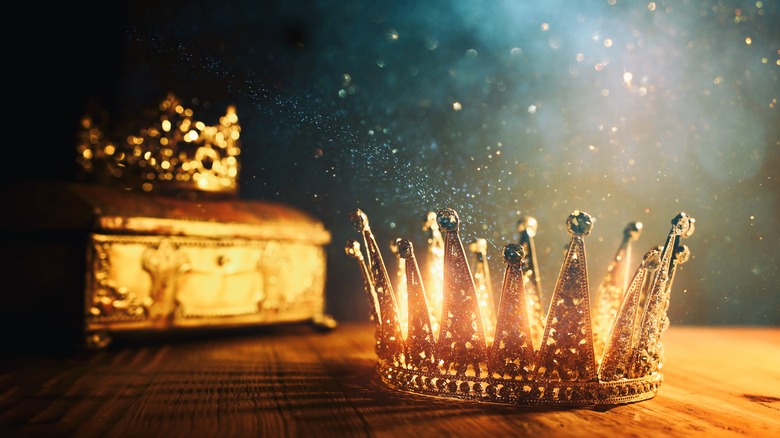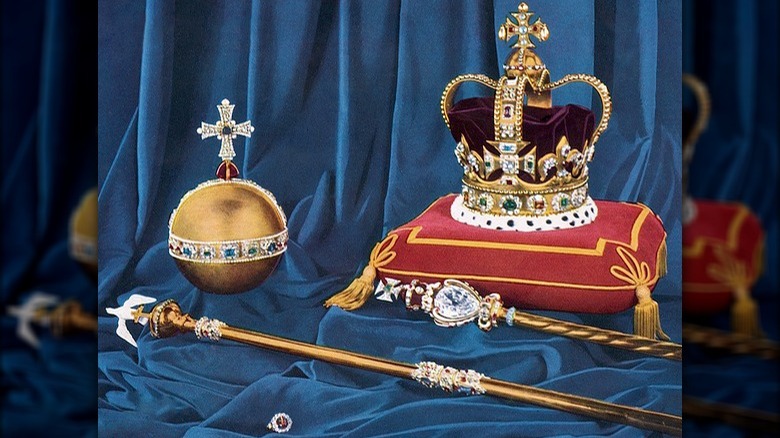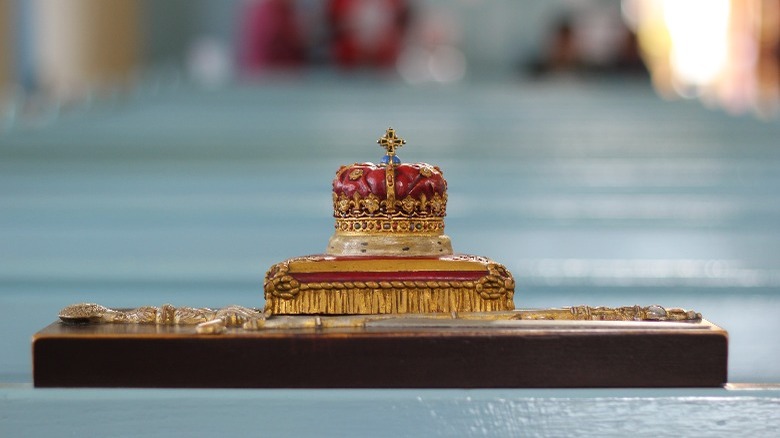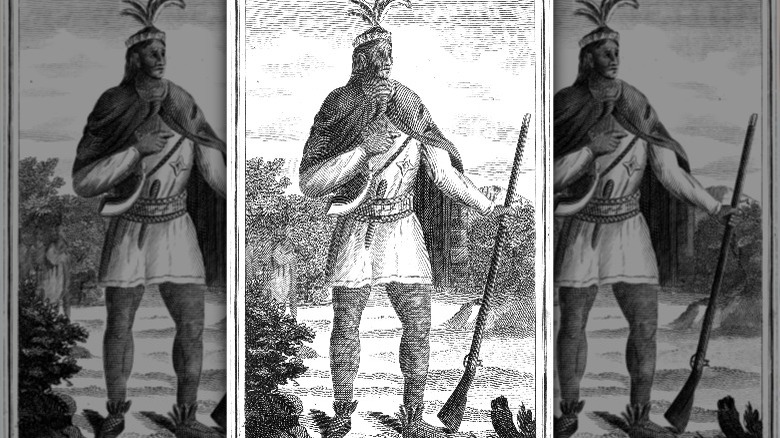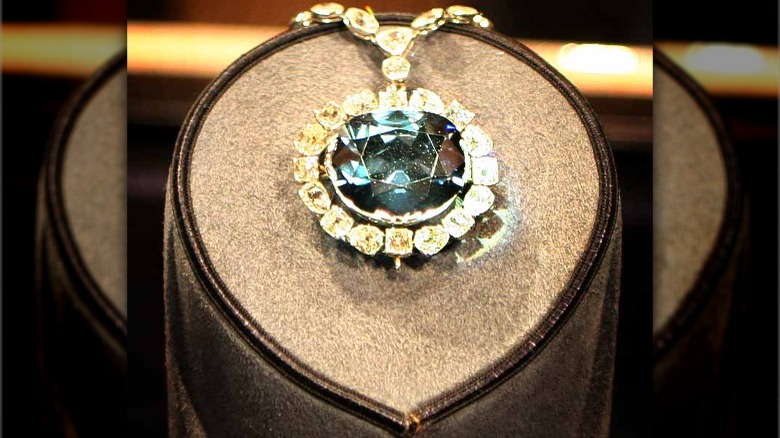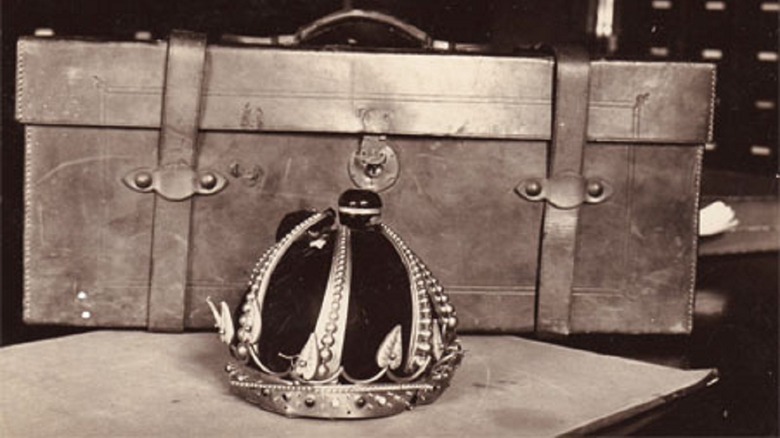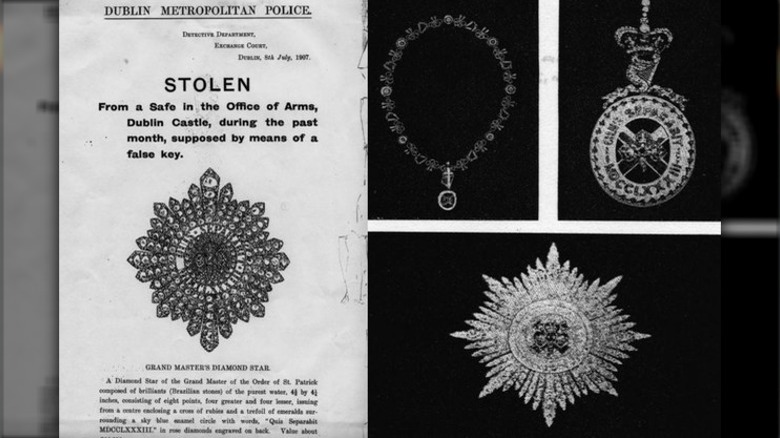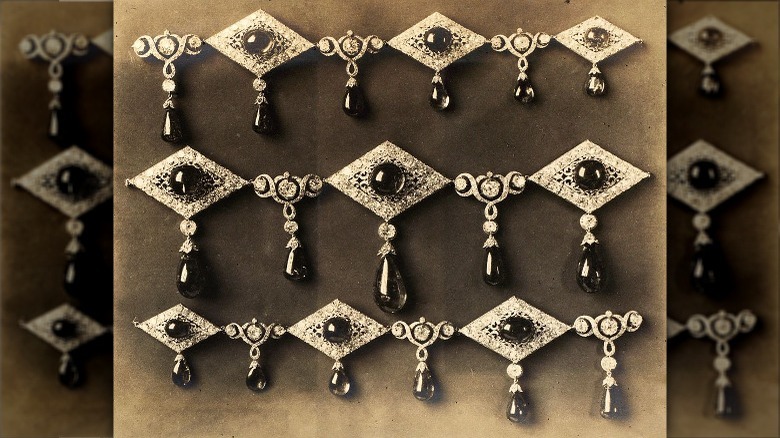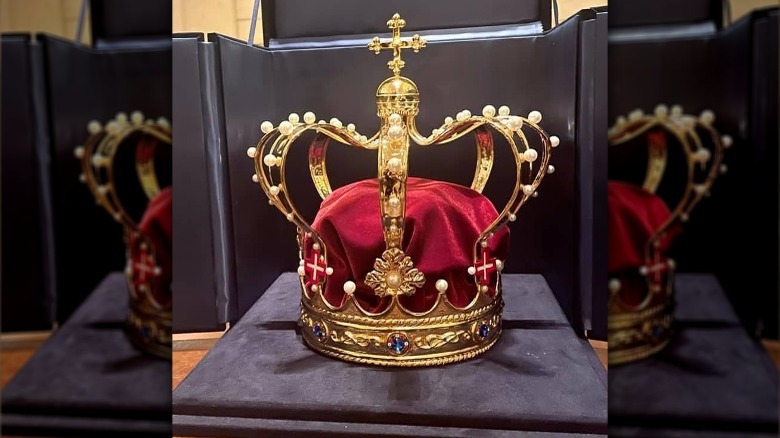Crown Jewels That Mysteriously Went Missing
Most of the time, when you hear the term "crown jewel," it seems to be in reference to the treasures kept by the British royal family, used and worn for special occasions like coronations. Really, though, it can also be used as a bit of a broader term, referring to valuables in the possession of a nation's royal family. In that case, you'd probably assume that the crown jewels are always kept behind lock and key, completely impossible to get at for anyone who isn't a mythical master thief. Or, at the very least, you wouldn't think that it was possible for these sorts of treasures to just go missing.
But here's the thing: The crown jewels of various different countries have disappeared throughout history, sometimes under circumstances that only seemed mysterious at the time, and sometimes in situations that no one has been able to fully solve to this day. There does seem to be a particular trend, though: A rather impressive amount of political turmoil seems to be going on around the time of the theft.
The vanishing acts pulled by these sets of crown jewels have been shrouded in both mystery and interesting history, so here are the facts as they're understood today.
The English crown jewels
It should be pretty telling that you've been a poor monarch when your nickname is literally "Bad King John," and you've been immortalized in fiction as the greedy villain fighting against Robin Hood. But considering the tenure of King John included losing land to France, starving the poor, losing the trust of the English barons to the point of signing the Magna Carta (a good thing in the long run, but a bad sign for the power of the monarchy), and inciting civil war, the reputation is warranted. Oh, and then to top it all off: He lost the English Crown Jewels, which were never to be found.
As the story goes, in 1216, King John was fleeing in the wake of all the discontent, and his convoy — carrying all sorts of valuables — chose a path that cut through a marsh known as the Wash. Just a week after that, the convoy and its contents were gone, and Bad King John was dead of dysentery.
It's generally believed that the carts were swallowed by the waters of the Wash — already a stroke of bad luck, to put it lightly, but King John's luck might have actually been even worse than once thought. Not only were the carriages swept up by the tides, but those tides might have actually been 22-foot-high waves caused by a rare astronomical event, burying the crown jewels deep under the mud.
The Scottish crown jewels
During the mid-17th century, England was in the midst of a civil war fought between those who supported the absolute power of the monarchy and others who didn't. Long story short: English king Charles I was executed and replaced by military man Oliver Cromwell, but the king's son Charles II fled to Scotland. Unsurprisingly, that wasn't the outcome that Cromwell was hoping for, and he marched his army into the country to take the Scottish crown jewels — more specifically known as the "Honours." After all, they were symbols of the monarchy that Cromwell fought to abolish. But when he broke past the walls of Edinburgh Castle, they were nowhere to be seen.
As it turned out, those in Scotland weren't about to surrender, and when it was clear that Edinburgh Castle was going to fall, the Honours were smuggled past the walls. From there, a group of women passed the treasures between them and took them far from the invading forces, sometimes hiding them within sacks, pillows, and even seaweed. Ultimately, they were buried on the grounds of Kinneff Church just shortly before Cromwell's forces took the castle. There they stayed for nine years, uncovered only when the monarchy was restored.
Strangely enough, that wasn't the end of the mystery of the Honours. From 1707 to 1818, they were considered lost once again, albeit for reasons that were hardly mysterious: They were locked in a box during a period of political change and subsequently forgotten.
[Featured image by Stefan Schäfer, Lich via Wikimedia Commons | Cropped and scaled | CC BY-SA 3.0]
The Wampanoag crown jewels
The term "crown jewels" likely brings to mind images of sparkling gems and plenty of diamonds, but there's a lost historical artifact belonging to the Wampanoag Nation that is revered instead for the elaborate lace hand-sewn into its design. That artifact is Metacom's belt.
The setting of this story is a late 17th-century conflict commonly known as King Philip's War, a massive conflict between Native Americans and English settlers that was really the eruption of decades of longstanding tensions over a number of issues. The fighting was bloody and the politics complicated, and in 1676, English soldiers ended up killing Wampanoag chief Metacom (referred to as King Philip by the English). As the conflict ended, the English took a number of Native American artifacts, including Metacom's belt, which contained the records of Wampanoag history and was further revered for the symbolism literally woven into it. The records kept didn't have any sort of end because future generations would keep adding to the story.
But that wouldn't end up being the case. The belt was given to Major Waldegrave Pelham, who was supposed to present it to King James II back in England. But then Pelham just vanished, taking the belt with him. For two years, no one even knew he'd disappeared. Once they figured it out, it was apparently too late for them to track him down. Even in the centuries since, nothing substantial on either Pelham or Metacom's belt has ever been found.
The French crown jewels
The French Revolution and the arrest of King Louis XVI and Marie Antoinette in 1791 brought about plenty of chaos. By September of the next year, rioting was rampant, and that was the perfect setting for the most ambitious of heists: stealing the crown jewels. Investigators found the culprit, Cadet Guillot Lordonner, was selling a red jewel from the collection in London. He also took a famously large blue diamond — known as the "French Blue" — but when Lordonner was captured, the gem wasn't on his person.
Mysteries endured, and the possible path the gem took wasn't really tracked until later. It's possible that it was in London in the 1790s, but some suspect the entire heist was set up by the government as a way to get that particular jewel. It might have been a bribe for Austrian and Prussian generals in exchange for their surrender in the war at the time; in that case, the gem might have made its way to London in the early 1800s. Either way, it cropped up sporadically in records throughout the 19th and 20th centuries, potentially residing with King George IV before finding its way to Henry Philip Hope (where it was renamed the "Hope Diamond"), then American heiress Evalyn Walsh McLean, and finally the Smithsonian Museum.
Even then, it wasn't clear that the Hope Diamond and the French Blue were the same jewels. It couldn't be proven until 2005 with the help of computer modeling and intense research.
[Featured image by Steve Evans from Citizen of the World via Wikimedia Commons | Cropped, scaled, and mirrored | CC BY 2.0]
The Hawaiian crown jewels
To say that the U.S. annexation of the Hawaiian Islands was a messy situation would be simplifying a controversial piece of history. That's an entire topic of its own, but when it comes to the Hawaiian crown jewels in particular, their fate likely didn't help matters at the time.
Just a few months after the deposition of Queen Liliuokalani, on April 3, 1893, Iolani Palace was in a bit of a state of flux. As keys were changing hands, a shocking discovery was made: The trunk holding King David Kalakaua's crown had been broken into. The crown itself was found mangled — the metal twisted and velvet torn — and bereft of all its precious jewels. Over 600 gems had been stolen, and from there, both the investigations and the rumors started. Fingers were pointed at Liliuokalani (or at least those working in her interest) as well as some shady figures seen around the area, but ultimately investigators found themselves a culprit in one of the guards. George Ryan reportedly sold a diamond to a fellow guard, and a whole handful of the stones were later found in the pockets of his vest.
As it turned out, Ryan had a whole network to fence his stolen goods. Carriage drivers were employed to casually sell the jewels to travelers and tourists that they shuttled back and forth. Even when this operation was discovered, the gems couldn't easily be recovered, as they'd already disappeared with random, unsuspecting visitors.
The Irish crown jewels
When it comes to the disappearance of the Irish Crown Jewels in 1907, there are plenty of lingering questions to go around.
The jewels and the safe they were stored in were to be moved to a heavily fortified tower in Dublin Castle, but they never got there. The door to the tower proved too small for the safe, which was then kept in the easily accessible library under the watch of Sir Arthur Vicars. Only, Vicars wasn't a fan of this duty, and it showed: The jewels were even stolen once by his friends as a prank. Then, there were a series of security incidents that Vicars seemingly ignored and culminated in the theft of the jewels on July 6.
The crime scene was left oddly meticulous (the thief even neatly folded up the cloth inside the safe), leading many to believe it was an inside job. But that's where the investigation gets tricky. A Scotland Yard investigator was brought in and penned a report that named the perpetrator, but that report was never released and the investigator was sent back to England. People suspect a coverup, and in that same vein, it's thought that Vicars became a scapegoat and was denied the chance to clear his name. But why a coverup? Vicars himself named Francis Shackleton as the true culprit, but investigating Shackleton potentially opened up the nobility to scrutiny — a side effect that King Edward VII was desperate to avoid.
The Russian crown jewels
If you've heard the legend of Anastasia, you know mysterious legends have long circled around the Romanov family, and those legends also extend to the crown jewels that they possessed.
Prior to 2012, historians believed that they knew of all the Russian crown jewels; a 1925 book called "Russia's Treasure of Diamonds and Precious Stones" had always been seen as the most comprehensive list in that regard. But that was changed by the discovery of a 1922 book called "The Russian Diamond Fund," which included photos of four unknown pieces: a tiara, a bracelet, a necklace (pictured above), and a brooch. Researchers questioned what these pieces were, why they weren't included in the later catalog, and whether this new book could even be trusted. The brooch was eventually tracked down — it was sold at auction in 1927 — but the other three pieces still haven't been accounted for.
As for why these pieces are missing, there are a couple of possible explanations. In the wake of the Russian Revolution, Bolshevik leaders were strapped for cash and considered selling the crown jewels, but they were convinced otherwise by the Kremlin, who argued for their historical significance. That doesn't mean that Soviet agents weren't caught sneaking off with diamonds in their luggage, though. Besides that, multiple stories abound of the Romanovs secreting away stores of their treasures, either hiding them away during their exile in Siberia or sending them or sending them off for safe keeping in China.
The Italian crown jewels
In Italy, the 1946 fall of the old ruling family, the House of Savoy, left behind a mystery regarding the Italian crown jewels. The vote for Italy to transition to a republic also led to the effective exile of the Savoys from the country, but their departure also aligned with the sudden disappearance of the crown jewels. For a few decades, rumors circled about just why the jewels had disappeared. Maybe they'd been stolen at some point, sold off in exchange for untold riches.
But the reality is far less exciting. Rather, just after the monarchy was dismantled, Italy's final king, Umberto II took the jewels to the Bank of Italy and guarded them with a simple leather box and a few conditions that, essentially, meant that it wouldn't be opened until someone from the monarchy approved of it. And that's where the jewels sat for 30 years, untouched and weathering the speculation until the Italian government decided to silence the rumors, meeting the conditions to open up the box again. They confirmed that the thousands of jewels had not, in fact, been stolen, and were safely untouched (if possibly less valuable than some people might have hoped).
Talk about the crown jewels hasn't stopped though, albeit for slightly different reasons. Vitriol toward the royal family has lessened in recent years, and they've been attempting to have the jewels returned to them. Unfortunately, it hasn't been entirely smooth sailing for them on that front.
[Featured image by Metterns via Wikimedia Commons | Cropped, scaled, and mirrored | CC BY-SA 4.0]
